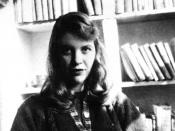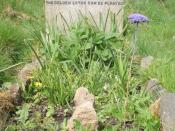Erica Prince
English IV DC
Mrs. Summers
April 5, 2004
Different Natures of Death Portrayed In Poetry
"Birth and death are not two different states, but they are different aspects of the same state. There is as little reason to deplore the one as there is to be pleased over the other," Mohandas Gandhi. Death is something that happens to any living thing, and it is something that everyone has to deal with at least once in their life whether it be the death of someone/something they know, or even their own death. People die; animals die; plants die; seasons fade away; even things within us, whether in our mind or in our body die. Death is found in many things besides life; it is found in novels, biographies, fantasy books, journals, and even in poetry. Poetry can be defined as, "writing that formulates a concentrated imaginative awareness of experience in language chosen and arranged to create a specific emotional response through meaning, sound, and rhythm".
In poetry, there are many types of deaths; death of children, violent death, death of innocence, and even the death of something once beautiful. There are some deaths that result in pain, nothing, or possibly even a rebirth or something terrible or beautiful. Through poetry people have been able to express these different kinds of death. In poetry, things are not always easily found. Sometime we have to look for hints the lead us to our conclusions about what a poem is really about. Other time it is obvious, almost like a donee. Death in poetry comes in many shapes and/or forms. Death can be found in poetry using foreshadowing, figurative langue, or many other things that help allude to the true meaning of the poem.. In "Here a Pretty Baby Lies" by Robert Herrick, "Richard Cory" by Edwin Arlington Robinson, "Mirror" by Sylvia Plath, and "she being Brand/ -new" by E.E. Cummings, an array of deaths are portrayed by their authors using irony, dues ex machine, and double entendre.
First off, is "Here a Pretty Baby Lies" by Robert Herrick. This poem is about the death of a child. Herrick's poem, thought extremely short, is saturated in irony. "Here a pretty baby lies/ Sung asleep with lullabies:", is used and alludes the reader into thinking that the baby is peacefully sleeping in it's crib, being sung to sleep. In the two following lines, the true irony is revealed; "Pray be silent and not stir/ Th'easy earth that covers her." The irony is clued by the words "Pray be silent and not stir". At this point, the author is cluing the reader in on what has really happened to the little girl. The line can be taken two ways. One could either interpret it as someone praying that the leave quietly and not wake the baby up, or interpret it as someone praying for their lost child, but being silent as to not stir their own emotions. "th'easy earth" can easily be a symbol for the little girl's parent(s)' emotions towards her death. The words "Pray be silent" can be a foreshadower of the child actually being dead. In this poem, Herrick makes the reader think the baby is alive, when in actuality, the child is buried, and someone is there to comfort her while she sleeps eternally. There is no rebirth for this child after it death, only a sense of longing from their parent(s). This poem shows that even children lie beneath the ground, having left their loved ones behind.
Secondly is "Richard Cory" by Edwin Arlington Robinson. In this specific poem, the author uses deus ex machina to catch the readers' attention. This poem is about a man who led an extraordinary life much envied by those below him. The author describes his humble personality though he was rich; "and he was always human when he talked;...And he was rich--yes, richer than a king--." The whole time the author makes one believe that Richard Cory lived a wonderful life and though one knows he is dead, by the extensive use of the word "was", makes them believe that he just died a natural death, nothing sudden, nothing violent. Suddenly comes the dues ex machine; the author quickly ends the poem, "and Richard Cory, one calm summer night/ Went home and put a bullet through his head." In this poem, there is no foreshadowing of Richard Cory's sudden/violent death, only the sudden, violent end of his life that he took into his own hands. This poem shows that death can even come to those that appear to be happy. Also, in this poem by Robinson, there is no rebirth; only those that remember him are left behind to carry on with their lives.
Next, is the poem "Mirror" by Sylvia Plath. The death found in this poem is very different from the death found in the other two poems above. The death found in this poem is the death of a young and beautiful girl into an old and ugly woman. The poem explains the death step by step through a mirror's point of view. "She rewards me with tears and an agitation of hands." The girl is finally realizing that she's not young anymore and that her youth has died. The mirror, also the narrator, finally comes out and tells the reader, "in me she has drowned a young girl, and in me and old woman/ rises toward her day after day, like a terrible fish." The mirror explains to the reader that through the mirror, the woman has drowned her beauty, and now all that meets it, the mirror, is an old and ugly woman, one that is portrayed as a dead, bellied-up fish. The death founding this poem shows the death of something that was once beautiful, and something ugly was reborn in its place. Though the reader can not see if she is really ugly, the sadness of the woman in the mirror and the mirror's point of view as well show us that they see her as ugly.


